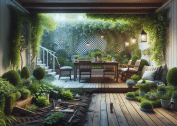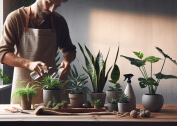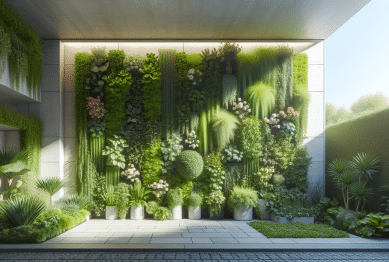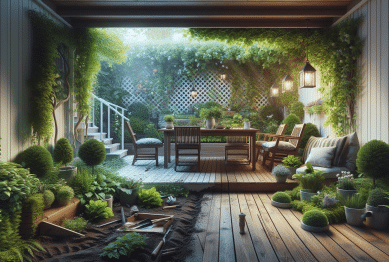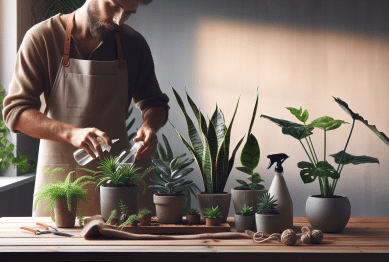Uncover the simple truths behind lush houseplants. This guide explores practical gardening techniques, tips for natural pest management, and lighting strategies to transform your home. Discover how indoor plant care can be easy and enjoyable, even for beginners, and learn what really matters for healthy, thriving greenery.
Making Indoor Plants Thrive With Little Effort
Houseplants bring fresh color and life to any room, but many believe caring for them is a challenge. The truth is, with understanding of your home’s light and humidity, plant care can be quite simple. Start by taking a walk around your home. Notice areas with the brightest windows, the darkest corners, and places with fresh air. Most popular indoor houseplant varieties, such as pothos and snake plant, tolerate moderate light and inconsistent watering. This adaptability is what makes them favorites. Use well-draining soil and containers with drainage holes to prevent root rot, a common issue for indoor plants. Regular observation lets you quickly spot when leaves droop or brown edges form, which are early signals for adjusting light or moisture.
Successful gardening inside depends more on observation than on buying expensive tools or fertilizers. Natural cycles—like seasonal changes in sunlight—matter for your green companions. Plants benefit from a gentle and regular routine: check soil with a finger before watering and turn pots to encourage even growth. It’s essential to clean dusty leaves, which can block essential light, and repot when roots peek from the container. Choosing plants that naturally fit your living environment lowers the risk of disappointment. Hardy species like zz plant or spider plant thrive in almost any home. Taking care of houseplants is less about perfection and more about giving them consistent, basic support.
Humidity and temperature swings also impact indoor greenery. Many common houseplants are native to tropical or subtropical climates, so they appreciate steady warmth and some moisture in the air. You can group plants together to raise humidity or use shallow trays filled with pebbles and water placed beneath pots (without letting the roots sit in water). Simple practices, like keeping plants away from cold drafts or hot radiators, protect them from sudden environmental stress. These small steps help maintain vibrant foliage and steady growth all year long.
Pest Management Without Harsh Chemicals
Even indoor gardens face occasional pests—think spider mites, aphids, or fungus gnats. You don’t need chemical sprays for effective pest control. Instead, try solutions with soap and water or neem oil. Mild liquid soap, diluted in water, safely washes away most soft-bodied pests. Apply it gently to leaf surfaces with a cloth or spray bottle. Neem oil, available at garden centers, is a plant-derived treatment that disrupts pests’ growth cycles and repels common insects. Simple, natural methods keep your indoor air healthier and protect beneficial microbes in potting mix.
Sometimes, preventing pests is about creating strong, healthy plants. Weakened or stressed greenery is more likely to attract invaders. Good indoor gardening practices—like regular cleaning, pruning, and not overwatering—remove dead material and reduce breeding spots. It also helps to quarantine new plants for a week or so before placing them near others, which allows you time to inspect for hidden bugs. Checking the undersides of leaves, where mites and aphids like to hide, is a quick habit that offers big results. Over-fertilizing can also make plants more prone to infestations, so use plant food sparingly according to label directions.
For stubborn infestations, a gentle rinse under the showerhead can quickly remove young bugs and their eggs. Sticky traps help monitor flying pests like fungus gnats. If an outbreak does occur, patience matters: repeat your chosen method every few days rather than relying on a single treatment. Indoor pest control combines careful habits and thoughtful plant care—no drastic action needed. Learn more about integrated pest management from university extension services and trusted gardening organizations.
Maximizing Natural Light for Growth
Light is the most important ingredient for healthy houseplants. All greenery needs energy from sunlight for photosynthesis. Assess your space: windows facing east offer gentle morning rays, while southern windows provide strong, direct light ideal for cacti and succulents. North-facing windows deliver soft, diffused light—great for ferns and low-light foliage. Use sheer curtains to diffuse harsh sun and avoid burning delicate leaves. Observing plants for signs like stretching stems or pale foliage helps adjust their placement for maximum natural benefit.
Artificial lighting isn’t just for professional greenhouses. Many LED grow lights are affordable and designed for household use, offering full-spectrum illumination that supports active plant growth in darker rooms or during winter. Position grow lights close to foliage, but not so near as to cause heat damage. A timer makes it easy to ensure plants receive at least eight to twelve hours of quality light each day, especially for flowering or fruiting varieties. With a little experimentation, any home can support light-loving species—even without sunny windows.
Don’t overlook the power of movement. Rotating your plants every week simulates the way natural light moves in the wild, encouraging balanced growth and full, bushy form. Some species, like monstera and philodendron, adapt quickly to shifts in lighting conditions. As you learn your home’s microclimates, you’ll develop intuition for each plant’s preference, supporting a diverse indoor garden without expensive gadgets or complicated strategies.
Choosing the Right Plants for Your Lifestyle
The right plant in the right place makes all the difference. Consider your home’s light and humidity, but also your schedule and maintenance habits. Low-maintenance houseplants like sansevieria, pothos, and philodendron tolerate occasional forgetfulness. For those with time for regular watering and misting, try ferns, calatheas, or peace lilies. Researching each species’ watering and light needs before purchase creates lasting success.
Allergies, pets, and children are important factors. Select non-toxic varieties such as spider plant, Boston fern, or parlor palm if curious hands or mouths will be nearby. Local botanical gardens and cooperative extensions provide plant lists and beginner guides, helping match greenery to specific living circumstances. For small spaces, explore vertical gardening, hanging planters, or wall-mounted displays—these create lush impact without using up valuable floor area.
Remember, your own enjoyment is a top consideration. Colorful blooms, textured leaves, and trailing vines all bring delight. Start small and expand as confidence grows. Community groups, online forums, and plant swaps offer opportunities to meet fellow enthusiasts and find advice rooted in real experience. Caring for houseplants is, ultimately, about building a connection with the natural world indoors, no matter your environment.
Creative Design Ideas to Showcase Indoor Gardens
Houseplants aren’t just functional—they’re beautiful design elements that refresh any room. Think beyond standard pots. Mix heights and shapes for a natural look: tall snake plants, trailing pothos, and tiny succulents make for striking groupings. Bookshelves, kitchen nooks, and bathroom counters all offer unexpected display opportunities. Terrariums and miniature gardens bring imaginative flair to desktop or bedside spaces. Creativity makes indoor gardening rewarding on many levels.
Consider using plant stands, ladders, or repurposed shelves to create living walls or tiered jungles. These arrangements bring volume and dimension to spaces, letting greenery fill vertical air rather than horizontal floor. Macrame or modern hanging baskets draw the eye upward, creating the illusion of higher ceilings and more space. Moving plants periodically not only keeps displays fresh but also enables you to adjust placement as seasons change.
The finishing touches—like grouping by color, varying leaf textures, or mixing plant types—transform simple gardening into home art. Matching planters to decor, adding natural stones, or framing a window view with greenery personalizes the space. Nature-inspired interiors influence well-being, with studies suggesting that biophilic design improves mood and focus. Let your home showcase that living beauty in ways that suit your style and needs.
Essential Tips for Long-Term Houseplant Health
Consistency is more important than perfection in indoor gardening. Develop simple routines: watering when soil is dry, turning pots for even exposure, checking for pests, and trimming tired leaves. Most houseplants prefer room-temperature water and dislike soggy roots. Routine feeding with balanced plant food during spring and summer supports energetic growth, while reduced feeding in fall and winter matches slower natural rhythms.
Learning from mistakes is part of every plant owner’s journey. Browning leaves, droopy stems, or yellow spots signal that something needs to change—maybe more light, less water, or a new spot. Take notes on what works and don’t worry about occasional setbacks. Each plant is unique. A willingness to adjust and adapt leads to lasting success with minimal frustration. Local extension services and online plant care guides offer support when problems arise, making troubleshooting convenient and effective.
Finally, embrace the joy and calm that houseplants bring. Studies suggest greenery helps purify the air, reduce stress, and add a sense of accomplishment to daily routines. A thriving indoor garden becomes a living companion, changing gently with the seasons and rewarding attention with new leaves and blossoms. Patience and curiosity are your greatest gardening tools—let them guide continual growth, both for your plants and yourself.
References
1. The United States Botanic Garden. (n.d.). Indoor Plant Care Guide. Retrieved from https://www.usbg.gov/plant-care/houseplants
2. University of Illinois Extension. (n.d.). Successful Indoor Plant Care. Retrieved from https://extension.illinois.edu/houseplants
3. Royal Horticultural Society. (n.d.). Houseplant Pests: Prevention and Control. Retrieved from https://www.rhs.org.uk/prevention-protection/pests/houseplants
4. Clemson Cooperative Extension. (n.d.). Growing Indoor Plants with Success. Retrieved from https://hgic.clemson.edu/factsheet/growing-indoor-plants-with-success/
5. Penn State Extension. (n.d.). Houseplant Pests and Problems. Retrieved from https://extension.psu.edu/houseplant-pests-and-problems
6. Texas A&M AgriLife Extension. (n.d.). Houseplants. Retrieved from https://aggie-horticulture.tamu.edu/houseplants/



